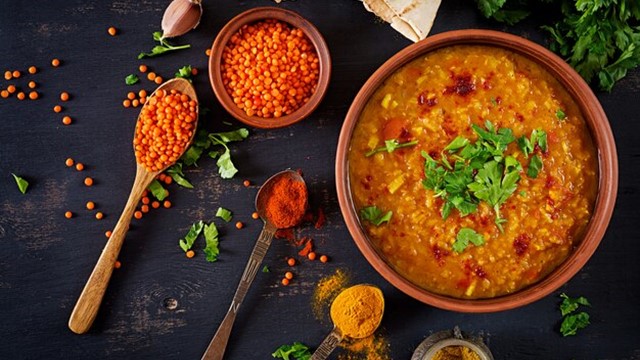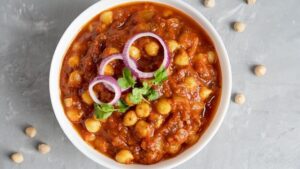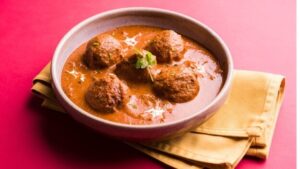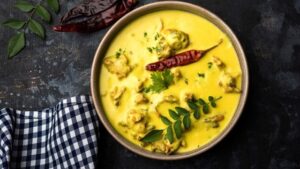Introduction:
Dal Tadka, a beloved dish in Indian cuisine, is more than a simple lentil curry – it’s a celebration of flavors, tradition, and comfort. In this culinary exploration, we’ll delve into the heartwarming world of Dal Tadka, uncovering its rich history, the art of preparation, and the soul-satisfying experience it brings to the table.
Dal Tadka, a classic Indian dish that promises a symphony of flavors and comforting aromas. Immerse yourself in the richness of spiced lentils, skillfully prepared with aromatic spices, creating a dish that’s not only hearty but a true celebration of traditional Indian cuisine. Join us on this flavorful journey and savor the essence of home-cooked goodness with every spoonful of our delectable Dal Tadka. It’s a dish that goes beyond nourishing the body – it nourishes the soul.
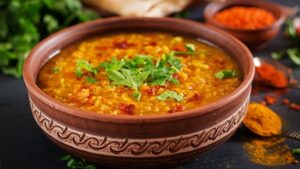
Origin and Heritage:
The origin and heritage of Dal Tadka can be traced back to the vibrant and diverse culinary landscape of North India. The dish is deeply rooted in the traditional cooking practices of Indian households, particularly in the states of Punjab, Haryana, and Uttar Pradesh. As a staple in North Indian cuisine, Dal Tadka has not only become a cherished part of daily meals but also holds cultural significance.
Historical Context:
The history of Dal Tadka is intertwined with the rich agricultural practices of North India, where lentils were cultivated abundantly. Lentils, being a protein-rich and nutritious ingredient, became a staple in the vegetarian diet of the region. The use of various spices in cooking, including the tempering technique known as “tadka,” has been a culinary tradition passed down through generations.
Culinary Evolution:
Over the years, the dish has evolved and adapted to regional preferences and ingredient availability. Different communities and households have added their unique twists, resulting in various regional variations of Dal Tadka. The use of specific lentils, spices, and aromatics may vary, but the fundamental concept of tempering lentils remains at the heart of the dish.
Family Traditions:
In Indian homes, the preparation of Dal Tadka often involves family traditions and the passing down of recipes from one generation to the next. Home cooks take pride in perfecting the art of tempering, ensuring that each element contributes to the overall flavor profile of the dish.
Cultural Significance:
Dal Tadka is not just a meal; it embodies the essence of Indian hospitality and familial warmth. It is a dish that brings people together, whether during everyday meals or festive gatherings. Its simplicity, coupled with the burst of flavors, makes it a symbol of comfort and nourishment.
Versatility and Adaptations
As Indian cuisine has spread globally, Dal Tadka has become a popular choice in Indian restaurants worldwide. Its adaptability and vegetarian nature make it a favorite among people of various cultural backgrounds. The dish transcends geographical boundaries, carrying with it the authenticity and heritage of North Indian culinary traditions.
In conclusion, Dal Tadka’s origin and heritage are deeply ingrained in the cultural tapestry of North India. Beyond being a delicious and nutritious dish, it serves as a connection to the region’s agricultural roots, family traditions, and the evolving landscape of Indian cuisine. Whether enjoyed in a rural kitchen or a cosmopolitan restaurant, Dal Tadka remains a testament to the timeless appeal of authentic and heartwarming Indian flavors.
Crafting the Perfect Dal Tadka:
Crafting the perfect Dal Tadka requires a blend of precision, patience, and a deep understanding of the harmonious marriage of ingredients. Here’s a step-by-step guide to help you master the art of creating this soul-soothing dish:
Ingredients:
Lentils:
- Choose lentils like toor dal (split pigeon peas) or masoor dal (red lentils) for a creamy texture. Rinse and soak them for a few hours before cooking.
Spices:
- Gather cumin seeds, mustard seeds, turmeric powder, garam masala, red chili powder, and asafoetida for the tempering. Adjust spice levels to your preference.
Aromatics:
- Onions, tomatoes, garlic, and ginger form the aromatic base. Finely chop or crush them for a robust flavor profile.
Cooking Fat:
- Use ghee or oil for tempering. Ghee adds a rich, nutty flavor, while oil is a suitable vegan alternative.
Fresh Herbs:
- Fresh coriander leaves (cilantro) add a burst of freshness. Reserve some for garnishing at the end.
Salt:
- Essential for seasoning the lentils and bringing out the flavors.
Cooking Process:
Preparing Lentils:
- Rinse lentils thoroughly and soak for a few hours (optional). Cook in a pressure cooker or on the stovetop until soft. Mash slightly for a creamy consistency.
Tempering (Tadka):
- Heat ghee or oil in a pan. Add cumin seeds and mustard seeds. Let them crackle to release their flavors.
Aromatic Base:
- Add finely chopped onions and sauté until golden brown. Then, add crushed garlic and ginger, allowing their aroma to infuse the oil.
Tomatoes:
- Incorporate diced tomatoes, cooking until they soften and the mixture becomes pulpy. This forms the luscious base of your Dal Tadka.
Spice Infusion:
- Sprinkle turmeric powder, garam masala, and red chili powder. Adjust the spice levels according to your taste. Asafoetida can also be added at this stage.
Merging Flavors:
- Combine the aromatic spice mix with the cooked lentils. Let the dal simmer, allowing the flavors to meld together. Adjust consistency with water if needed.
Seasoning:
- Season the dal with salt, tasting and adjusting as necessary. Remember that lentils absorb salt, so it’s essential to taste as you go.
Garnishing:
- Finish the dish by garnishing with freshly chopped coriander leaves. The vibrant greens add a pop of color and freshness.
Optional Additions:
- For an extra layer of richness, you can add a dollop of butter or cream just before serving. This step is optional but elevates the dish’s indulgence.
Serving:
Pairing:
- Serve the Dal Tadka with steamed basmati rice, naan, or roti for a complete and satisfying meal.
Garnish:
- A final sprinkle of fresh coriander leaves and a squeeze of lemon juice before serving enhances the overall presentation and flavor.
Mastering the perfect Dal Tadka is an art that evolves with each attempt. Feel free to experiment with spice levels and ingredient ratios to tailor the dish to your preferences. Whether it’s a comforting weeknight meal or a special occasion feast, your homemade Dal Tadka is sure to be a culinary masterpiece.
The Heart of the Dish:
At the heart of the aromatic and flavorful masterpiece that is Dal Tadka lies the artful combination of lentils and the enchanting process of tempering. This culinary symphony not only satisfies the palate but also tells a story of tradition, warmth, and the rich tapestry of Indian cuisine.
Lentils – The Soulful Base:
The choice of lentils forms the foundation of Dal Tadka. Toor dal (split pigeon peas) or masoor dal (red lentils) are commonly used, each imparting a distinct texture and flavor to the dish. These lentils, rich in protein and nutrients, transform into a velvety consistency, creating a comforting canvas for the spices and aromatics.
Tempering (Tadka) – A Dance of Flavors:
The heart of Dal Tadka beats with the rhythmic tempering of spices, an age-old technique that elevates the dish to unparalleled heights. Here’s how the enchanting process unfolds:
Cumin and Mustard Seeds:
The tempering begins with the sizzle of cumin seeds and the pop of mustard seeds in hot oil or ghee. These seeds release their aromatic oils, infusing the entire kitchen with a heady fragrance that signals the beginning of a culinary journey.
Asafoetida (Hing):
A pinch of asafoetida is added, imparting a subtle umami flavor and aiding in digestion. This mysterious spice, often referred to as the “devil’s dung,” contributes a unique depth to the dish.
Aromatics – Crafting the Flavor Symphony:
As the tempering dance unfolds, the aromatic trio of onions, tomatoes, and garlic takes center stage. These ingredients, finely chopped or crushed, add layers of complexity to the dish.
Onions:
Sautéed to a golden brown, onions lend a natural sweetness and depth, creating a robust base for the curry.
Tomatoes:
Diced tomatoes follow, softening and melding with the onions to form a luscious, pulpy mixture. The marriage of these ingredients creates the heartwarming essence of Dal Tadka.
Garlic and Ginger:
Crushed garlic and ginger join the medley, releasing their aromatic notes and infusing the oil with their distinctive flavors. This aromatic blend becomes the beating heart of the dal, enveloping it in warmth.
Spice Infusion – A Burst of Colors and Flavors:
Turmeric powder, garam masala, and red chili powder are sprinkled into the pan, creating a burst of colors and a melody of flavors. This spice infusion transforms the humble lentils into a tantalizing symphony, each spice contributing its unique note to the composition.
Merging Flavors – Harmony in Simmering:
The tempered spices and aromatic base merge with the cooked lentils, creating a harmonious blend. As the dal simmers, the ingredients intermingle, allowing the flavors to dance together and reach a crescendo of taste.
Conclusion: A Culinary Love Affair:
The heart of Dal Tadka beats with the love and passion poured into each stage of its creation. From the choice of lentils to the enchanting tempering process, every step is a testament to the artistry embedded in Indian home cooking. As you savor a spoonful of this delightful dish, you taste not just a meal but the heart and soul of a culinary tradition passed down through generations.
Pairing and Serving:
Pairing and serving Dal Tadka is an art that involves creating a balance of flavors and textures. Whether you’re aiming for a comforting weekday meal or hosting a festive gathering, thoughtful pairings enhance the overall dining experience. Here’s a guide to elevate your Dal Tadka to a delightful feast:
Pairing Options:
Steamed Basmati Rice:
- Why: The fluffy and aromatic basmati rice serves as a perfect canvas, absorbing the rich and flavorful Dal Tadka. The mildness of the rice complements the spiciness of the dal.
- Tip: Garnish the rice with a handful of chopped cilantro for added freshness.
Indian Breads (Roti, Naan, or Paratha):
- Why: Soft and pillowy Indian breads are an excellent accompaniment, offering a delightful contrast in texture. They are perfect for scooping up the thick dal.
- Tip: Brush the bread with a touch of ghee for an extra layer of richness.
Cumin Rice (Jeera Rice):
- Why: Fragrant cumin rice adds an aromatic and subtly spiced element to the meal. The earthy flavor of cumin complements the spices in the Dal Tadka.
- Tip: Garnish the rice with toasted cumin seeds for an extra burst of flavor.
Quinoa:
- Why: For a healthy twist, pair Dal Tadka with quinoa. The nutty flavor and fluffy texture of quinoa provide a nutritious base for the dal.
- Tip: Mix chopped fresh vegetables into the quinoa for added color and crunch.
Salad:
- Why: A crisp and refreshing salad adds a burst of freshness to the meal. The cool contrast of raw vegetables complements the warmth of the dal.
- Tip: Prepare a simple cucumber-tomato-onion salad with a squeeze of lemon juice and a sprinkle of chaat masala.
Garnishes:
Fresh Coriander Leaves:
- Why: A generous sprinkle of fresh coriander leaves adds a burst of color and freshness. The herbaceous aroma complements the spices in the dal.
- Tip: Reserve some coriander for garnishing just before serving.
Lemon Wedges:
- Why: Tangy lemon wedges provide a zesty kick that enhances the overall flavor profile of the dal.
- Tip: Squeeze fresh lemon juice over the dal just before serving.
Optional Additions:
Yogurt or Raita:
- Why: A cool and creamy yogurt or raita helps balance the spiciness of the dal, offering a soothing element.
- Tip: Prepare a simple cucumber and mint raita for a refreshing side.
Pickles or Chutney:
- Why: Spicy or tangy pickles or chutneys add an extra layer of flavor to the meal.
- Tip: Choose a pickle variety that complements the dal, such as mango pickle or mint chutney.
Presentation Tips:
Bowl or Plate:
- Why: Serve the Dal Tadka in a deep bowl or on a plate with a well to hold the dal. This helps contain the flavorful broth.
Individual Servings:
- Why: Consider serving individual portions for an elegant presentation, especially when hosting guests.
Family-Style:
- Why: For a cozy family meal, present the Dal Tadka in a large serving bowl and let everyone help themselves.
By paying attention to pairings, garnishes, and presentation, you can turn your Dal Tadka into a complete and satisfying dining experience. Experiment with these suggestions to find your perfect combination and make every serving of Dal Tadka a memorable affair.

